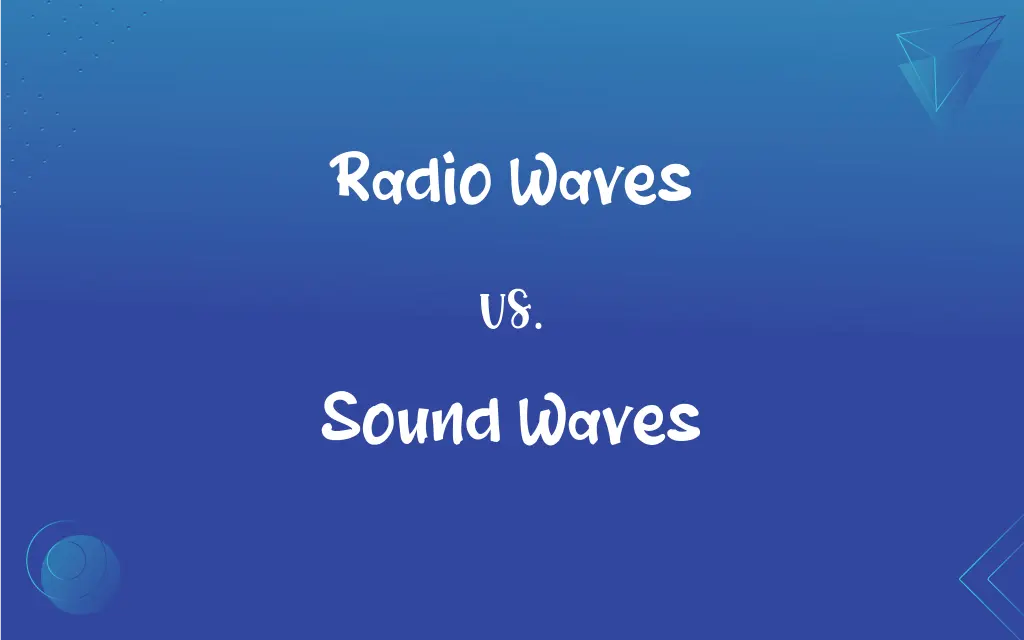Radio Waves vs. Sound Waves: What's the Difference?
Edited by Janet White || By Harlon Moss || Updated on October 11, 2023
Radio waves are electromagnetic waves used for wireless communication, while sound waves are mechanical waves that transmit audible or inaudible sounds through a medium.

Key Differences
Radio waves and sound waves fundamentally differ in their physical characteristics and applications. Radio waves belong to the electromagnetic spectrum and do not require a medium to travel through, meaning they can move through a vacuum. On the other hand, sound waves are mechanical waves, propagating through a medium like air, water, or solid materials.
In the context of communication, radio waves have significantly impacted the way information is transmitted over long distances. Utilizing antennas, radio waves transmit information by varying frequency or amplitude, enabling communication devices like televisions, radios, and cell phones to receive information wirelessly. Sound waves, while essential for verbal communication and perception of various sounds in our environment, are limited by distance and the medium through which they travel.
The speed of radio waves and sound waves also presents a remarkable difference. Radio waves travel at the speed of light, approximately 299,792 kilometers per second (km/s), enabling rapid transmission of information across vast distances. In contrast, sound waves move substantially slower, with the speed depending on the medium (approximately 343 meters per second (m/s) in air at room temperature).
In technology and research, radio waves have facilitated advancements in areas like radio astronomy, allowing scientists to observe distant astronomical objects and phenomena. Sound waves have their unique applications in technologies such as ultrasonography and sonar, exploiting their ability to interact with and reflect off objects to visualize structures or detect objects underwater.
Understanding the distinct behaviors and applications of radio and sound waves is crucial in fields like communication, medicine, navigation, and astronomical research, wherein precise wave manipulation is vital to technological and scientific advancements.
ADVERTISEMENT
Comparison Chart
Type of Wave
Electromagnetic wave
Mechanical wave
Medium
Can travel through a vacuum
Requires a medium
Speed
Approx. 299,792 km/s
Varies, approx. 343 m/s in air
Applications
Communication, astronomy
Hearing, ultrasonography
Frequency Range
3 kHz to 300 GHz
20 Hz to 20 kHz (audible)
ADVERTISEMENT
Radio Waves and Sound Waves Definitions
Radio Waves
Radio waves can be modulated in different ways (e.g., amplitude, frequency) to encode and transmit information.
In amplitude modulation (AM) radio, the strength of the radio waves is varied to encode signals, whereas in frequency modulation (FM) radio, the frequency is altered.
Sound Waves
Sound waves are vibrations that travel through a medium, like air or water, and can be heard when they reach a listener’s ear.
The sound waves from the concert speakers reached every corner of the arena, energizing the audience.
Radio Waves
Radio waves can vary in frequency and wavelength, offering various applications across different bands.
Different frequencies of radio waves are utilized for specific purposes, such as FM radio broadcasting and Wi-Fi communication.
Sound Waves
The amplitude, frequency, and speed of sound waves determine their loudness, pitch, and speed, respectively.
The pitch of sound waves is perceived as higher when the frequency is increased, like pressing a higher key on a piano.
Radio Waves
Radio waves belong to the electromagnetic spectrum, possessing both electric and magnetic field components.
Radio waves, being part of the electromagnetic spectrum, can travel through the vacuum of space, enabling interstellar communication.
Sound Waves
Sound waves below 20 Hz and above 20 kHz are termed infrasound and ultrasound, respectively, both typically inaudible to the human ear.
Bats utilize sound waves in the ultrasonic range for echolocation, navigating, and hunting in darkness.
Radio Waves
Radio waves are harnessed in technologies like radar to detect the location, speed, and distance of objects.
Radar systems emit radio waves and analyze the reflected signals to navigate or detect other vessels in aviation and maritime contexts.
Sound Waves
Sound waves are categorized into longitudinal waves as the particles of the medium move parallel to the wave's direction.
Sound waves traveling through air involve particles vibrating back and forth in the same direction that the wave is moving.
Radio Waves
Radio waves facilitate wireless communication by transmitting signals between devices.
Cell phones use radio waves to communicate with nearby cell towers, enabling wireless communication.
Sound Waves
Sound waves can be reflected, refracted, and absorbed, changing direction or being muffled by various materials.
The sound waves in the auditorium were absorbed by the curtains and cushions, preventing echoes and ensuring clear acoustics.
FAQs
What are radio waves?
Radio waves are electromagnetic waves used for wireless communication and broadcasting.
How do sound waves travel?
Sound waves travel as vibrations through a medium, such as air, water, or solids.
What is the speed of sound waves in air?
Sound waves typically travel at approximately 343 meters per second in air at room temperature.
What determines the frequency of radio waves?
The frequency of radio waves is determined by the oscillations of electrons in the transmitting antenna.
Can radio waves travel through a vacuum?
Yes, radio waves can travel through a vacuum, unlike sound waves.
Can humans hear all sound waves?
No, humans typically hear sound waves within a frequency range of 20 Hz to 20 kHz.
How are radio waves generated?
Radio waves are typically generated using electronic devices like transmitters and antennas.
How fast do radio waves travel?
Radio waves travel at the speed of light, approximately 299,792 kilometers per second.
Can radio waves be seen by the human eye?
No, radio waves are not visible to the human eye as they are outside the visible spectrum.
How are radio waves utilized in medicine?
Radio waves are employed in medical applications like MRI for detailed imaging of structures inside the body.
What generates sound waves?
Sound waves are generated by vibrating objects, which create pressure waves in a surrounding medium.
How are radio waves used in communication?
Radio waves transmit information wirelessly by modulating wave properties like amplitude or frequency.
Are sound waves and light waves similar?
While both are waves, they differ significantly; sound waves are mechanical and light waves are electromagnetic.
Can radio waves be harmful to humans?
High-intensity radio waves or prolonged exposure to certain radio frequencies may have harmful effects.
How are sound waves utilized in medical imaging?
Sound waves, specifically ultrasonic waves, are used in ultrasound imaging to visualize internal body structures.
How is the frequency of sound waves related to pitch?
The frequency of sound waves is directly related to pitch; higher frequencies are perceived as higher pitches.
Can radio waves interfere with other electronic devices?
Yes, radio waves can potentially interfere with the functioning of some electronic devices.
What are the properties of sound waves?
Key properties of sound waves include amplitude, wavelength, frequency, and speed.
How is the amplitude of sound waves related to loudness?
The amplitude of sound waves correlates with loudness; larger amplitudes are perceived as louder sounds.
What factors affect the speed of sound waves?
The medium, temperature, and pressure significantly influence the speed of sound waves.
About Author
Written by
Harlon MossHarlon is a seasoned quality moderator and accomplished content writer for Difference Wiki. An alumnus of the prestigious University of California, he earned his degree in Computer Science. Leveraging his academic background, Harlon brings a meticulous and informed perspective to his work, ensuring content accuracy and excellence.
Edited by
Janet WhiteJanet White has been an esteemed writer and blogger for Difference Wiki. Holding a Master's degree in Science and Medical Journalism from the prestigious Boston University, she has consistently demonstrated her expertise and passion for her field. When she's not immersed in her work, Janet relishes her time exercising, delving into a good book, and cherishing moments with friends and family.
































































